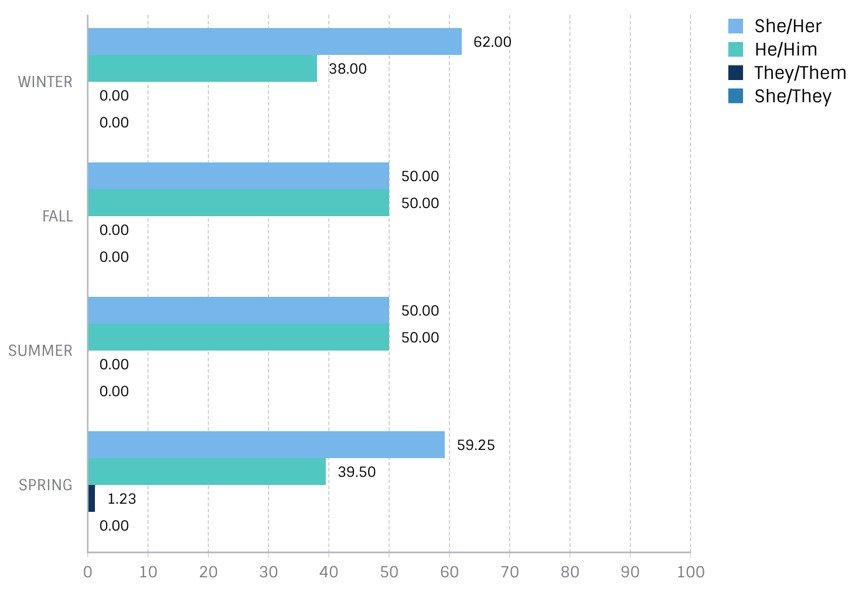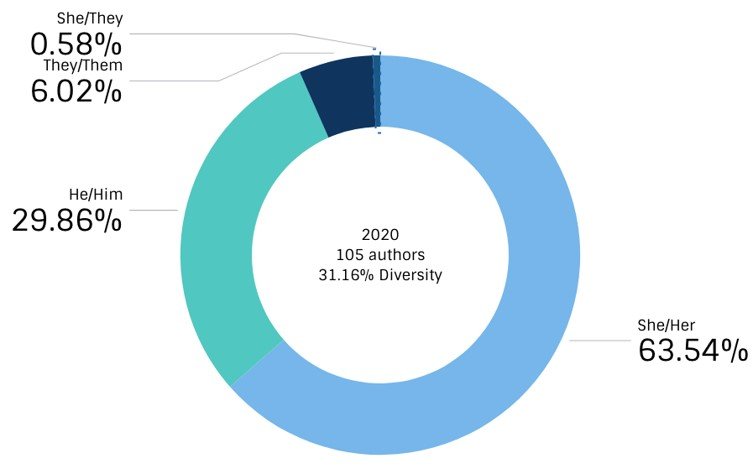Gender Diversity in Publishing | Case Study: Ploughshares
Introduction
VIDA is a “non-profit, intersectional feminist literary organization” that focuses on diversity in publishing. Their annual count compiles data from 40 literary journals and periodicals with the intent of “creating transparency surrounding gender imbalances and the lack of diversity in the literary landscape.” Like traditional ‘Big Five’ publishing, prominent literary magazines have a history of unevenly promoting the work of white, male authors over any other voices. With work like the VIDA count and general shifts in cultural demand for more diversity and representation, many publications have made statements about their commitment to improving—but do the results reflect the intention?
I chose three different literary magazines to perform my own VIDA count with, each across three years. The gender data used is based on which pronouns each author used to identify themselves in their bio. Overall diversity was more difficult to track—if the author noted their race, ethnicity, sexuality, etc in their bio or on their website, they were included in the percentage. However, no author is required to relay every aspect of their identity to the public, so the number represents an ‘at least’ tally rather than complete accuracy. The pie chart represents an annual average of the numbers. The following bar graph shows the percentages in each issue published that year. The radial percentage notes the wider diversity in each issue.
This web series is just a glimpse into a small portion of the larger literary landscape. Lacking the resources of the dedicated VIDA team, it would have been impossible for me to track long-term patterns all on my own in the time-frame of the project. However, even in this limited data collection, the findings are eye-opening. Representation is there. But there is still a lot of improvement that needs to be made in the world of the literary magazine and beyond.
Some Brief Reflections
In Ploughshares’ ‘Statement of Commitments,’ they define their foundational mission statement as “publishing exceptional work by emerging and established writers that pushes the boundaries of what is possible in art…writers who might otherwise be marginalized or outright excluded.” It is one thing for a publication to express an intent of diversity, but another thing entirely to follow through and show that commitment. Looking at the data from their three most recent years of publication, it seems that Ploughshares succeeds in overcoming the general gender imbalance favoring men in publishing—none of the 12 issues tallied ended up with a higher percentage of authors identifying as he/him than those identifying as she/her. The average percentage of diversity was on a consistent rise as well across three years.
This publication was unique from the two others I looked at in that their approach to individual issues within the same year was different. For example, the Fall 2022 issue published only longform pieces, and so only had 10 authors. On the opposite end of the spectrum, Spring 2022 published 73 different authors in poetry alone, with an additional 9 prose pieces. Looking at average percentages of gender diversity presents a good overall idea of the publication, but separating the issues like this also allowed me to view the attention to representation in different contexts. There is significantly more space available for a wide range of voices in an issue that publishes shorter pieces in greater quantity, but for an issue that limits itself to fewer, longer pieces, it may be prudent to more carefully consider what voices are being platformed over others.
2022 Data
2022 | Overall Gender Diversity in Ploughshares
2022 | Gender Diversity in Ploughshares by seasons
2022 | Overall Gender Diversity in Ploughshares by seasons
2021 Data
2021 | Overall Gender Diversity in Ploughshares
2021 | Gender Diversity in Ploughshares by seasons
2021 | Overall Gender Diversity in Ploughshares by seasons
2020 Data
2020 | Overall Gender Diversity in Ploughshares
2020 | Gender Diversity in Ploughshares by seasons
2020 | Overall Gender Diversity in Ploughshares by seasons








